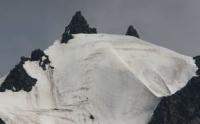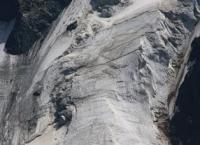You are here
History of study of Tuyuk-Su glacier.


Walk to Tuyuk-Su glacier.
“Since then, the same snow-white watermark has been imprinted on the sheet of my life, which sometimes shone through the multi-colored events of the next twenty years. It is hard to say why the mountains made such an indelible impression on me, but I constantly remembered them, not losing hope of breathing in that mountain air again, which cools the larynx so sweetly in early April, while the hot high-mountain sun burns the lips."
V.A. Soloukhin.
Sights of upper reaches of Malaya Almatinka river.
The glaciers of the Trans-Ili Alatau (about 400 of them) occupy an area of about 420 square kilometers. They contain about 25 cubic kilometers of ice. Glaciers are not stable systems, they are constantly in the process of transformation.
Modern processes take place against the background of a general change in natural conditions and anthropogenic impact. Glaciers are affected by climate change, especially fluctuations in air temperature and moisture.
Undoubtedly, the most visited and studied glacier of the Zailiysky Alatau is the Central Tuyuk-Su in the upper reaches of the Malaya Almatinka river valley. Its history is amazing:
1902
Glaciologist S.E. Dmitriev discovered and described the Tuyuk-Su mountain-glacial basin, with the largest glacier "Central Tuyuk-Su". Dmitriev was the first to visit it and made observations on it for the speed of movement and the position of the tongue. In 1902 and 1905, he first determined the height of the snow line at 3680 meters above sea level.
1910.
In 1910, S. E. Dmitriev discovered the Shokalsky Glacier in the upper reaches of the Sredniy Talgar River on the northern slope of the Zailiyskiy Alatau ridge.
1916
Glaciologist V.D. Gorodetsky visited the area of the Tuyuk-Su glacier and photographed its central part. In the photograph, the entire lower part of the glacier (1.5 kilometers up) was a powerful monolith without traces of surface contamination, reaching the level of rocks in a short spur separating the basins of the main glacier and the Molodyozhny glacier.
1922, 1923, 1926.
N.N. Palgov, the founder of glaciological science in Kazakhstan, made expedition trips to the Tuyuk-Su region. The results of his observations confirmed the visual impressions compiled on the basis of the analysis of Gorodetsky's photographs.
1937
After a 10-year break, an expedition was organized by the Hydrometeorological Service of the Kazakh SSR under the leadership of G.R. Yunusov as part of V.G. Gorbunova, M.P. Zatullo and R.G. Timofeev, which initiated the systematic study of the basin.
The glaciers were photographed on the plan, and on three of them - the Central Tuyuk-Su, the Tuyuk-Su Needles and Youth - observations were made of melting and movement.
1938
The second expedition repeated the same program of observations, which then continued until 1943.
1946
Studies of the Tuyuk-Su glaciers were resumed by the Sector of Geography of the Academy of Sciences of the Kazakh SSR under the leadership of N.N. Palgov. In the early 50s, well-known scientists worked here: climatologist L.N. Demchenko, glaciologist P.A. Chekasov, geologist L.Ya. Serov, geographer V.A. Zenkova, geographer-glaciologist K.G. Makarevich.
1957
Observations on the Tuyuk-Su glaciers have been started under the program of the IGY “Zaili glacier expedition of the Academy of Sciences of the Kazakh SSR”. This basin has become a permanent experimental base for Kazakh glaciologists.
1968
On the tongue of the Central Tuyuksu glacier, the seasonal meteorological station Tuyuk-Su-2 began to operate, which, along with the main meteorological and heat-balance observations, measured the ablation of snow and ice near the meteorological site. In the summer, the same station was also organized in the glacier cirque and was called Tuyuksu-3.
1971
On the moraine of the Molodyozhny glacier, the forces of the Zaili glacier expedition built two wooden houses with an area of 54 square meters each. This significantly improved the living conditions of glaciologists and had a positive impact on the process of observing and research work.
Year-round observations of the formation and distribution of snow reserves in the mountain-glacial basin, precipitation, river runoff, the regime of moraine lakes, snow avalanche and mudflow conditions were resumed.
Geographical coordinates of Tuyuk-Su glacier: N43°03'50 E77°04'45

Authority:
https://trekkingclub.kz/index.php?p=324
Photos by:
Alexander Petrov.







